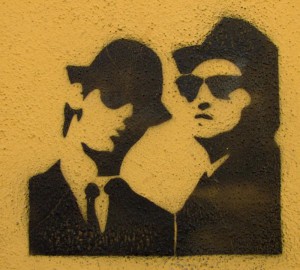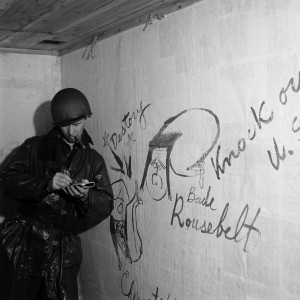Graffiti writing is often seen as having become intertwined with hip hop culture and the myriad international styles derived from New York City Subway graffiti. However, there are many other instances of notable graffiti this century. Graffiti have long appeared on building walls, in latrines, railroad boxcars, subways, and bridges.
During World War II and for decades after, the phrase “Kilroy was here” with an accompanying illustration was widespread throughout the world, due to its use by American troops and ultimately, filtering into American popular culture. A popular graffito of the 1970s was the legend “Dick Nixon Before He Dicks You”, reflecting the hostility of the youth culture to that U.S. president.
 Rock and roll graffiti is a significant sub genre. A famous graffito of the twentieth century was the inscription in the London tube reading “Clapton is God” in a link to the guitarist Eric Clapton. The phrase was spray-painted by an admirer on a wall in an Islington Underground station in the autumn of 1967. The graffiti was captured in a photograph, in which a dog is urinating on the wall. Graffiti also became associated with the anti-establishment punk rock movement beginning in the 1970s. Rock bands widely stenciled their names and logos, while many punk night clubs, squats, and hangouts are famous for their graffiti. In the late 1980s the upside down Martini glass that was the tag for punk band Missing Foundation was the most ubiquitous graffito in lower Manhattan, and was copied by hard core punk fans throughout the US and West Germany.
Rock and roll graffiti is a significant sub genre. A famous graffito of the twentieth century was the inscription in the London tube reading “Clapton is God” in a link to the guitarist Eric Clapton. The phrase was spray-painted by an admirer on a wall in an Islington Underground station in the autumn of 1967. The graffiti was captured in a photograph, in which a dog is urinating on the wall. Graffiti also became associated with the anti-establishment punk rock movement beginning in the 1970s. Rock bands widely stenciled their names and logos, while many punk night clubs, squats, and hangouts are famous for their graffiti. In the late 1980s the upside down Martini glass that was the tag for punk band Missing Foundation was the most ubiquitous graffito in lower Manhattan, and was copied by hard core punk fans throughout the US and West Germany.
In 1979, graffiti artist Lee Quinones and Fab 5 Freddy were given a gallery opening in Rome by art dealer Claudio Bruni. For many outside of New York, it was their first encounter with their art form. Fab 5 Freddy’s friendship with Debbie Harry influenced Blondie’s single “Rapture” (1981), the video of which featured Jean-Michel Basquiat, and offered many their first glimpse of a depiction of elements of graffiti in hip hop culture. JaJaJa toured Germany, Switzerland, Belgium, and Holland with a large graffiti canvas as a backdrop. Charlie Ahearn’s independently released fiction film Wild Style (1983), the early PBS documentary Style Wars (1983), hit songs such as “The Message” and “Planet Rock” and their accompanying music videos (both 1982) contributed to a growing interest outside New York in all aspects of hip hop.
 Style Wars depicted not only famous graffiti artists such as Skeme, Dondi, MinOne, and ZEPHYR, but also reinforced graffiti’s role within New York’s emerging hip-hop culture by incorporating famous early break-dancing groups such as Rock Steady Crew into the film and featuring rap in the soundtrack. Style Wars is still recognized as the most prolific film representation of what was going on within the young hip hop culture of the early 1980s. Fab 5 Freddy and Futura 2000 took hip hop graffiti to Paris and London as part of the New York City Rap Tour in 1983. Hollywood also paid attention, consulting writers such as PHASE 2 as it depicted the culture and gave it international exposure in movies such as Beat Street.
Style Wars depicted not only famous graffiti artists such as Skeme, Dondi, MinOne, and ZEPHYR, but also reinforced graffiti’s role within New York’s emerging hip-hop culture by incorporating famous early break-dancing groups such as Rock Steady Crew into the film and featuring rap in the soundtrack. Style Wars is still recognized as the most prolific film representation of what was going on within the young hip hop culture of the early 1980s. Fab 5 Freddy and Futura 2000 took hip hop graffiti to Paris and London as part of the New York City Rap Tour in 1983. Hollywood also paid attention, consulting writers such as PHASE 2 as it depicted the culture and gave it international exposure in movies such as Beat Street.
This period also saw the emergence of the new stencil graffiti genre. Some of the first examples were created in 1981 by graffiti artist Blek le Rat in Paris; by 1985 stencils had appeared in other cities including New York City, Sydney, and Melbourne.




